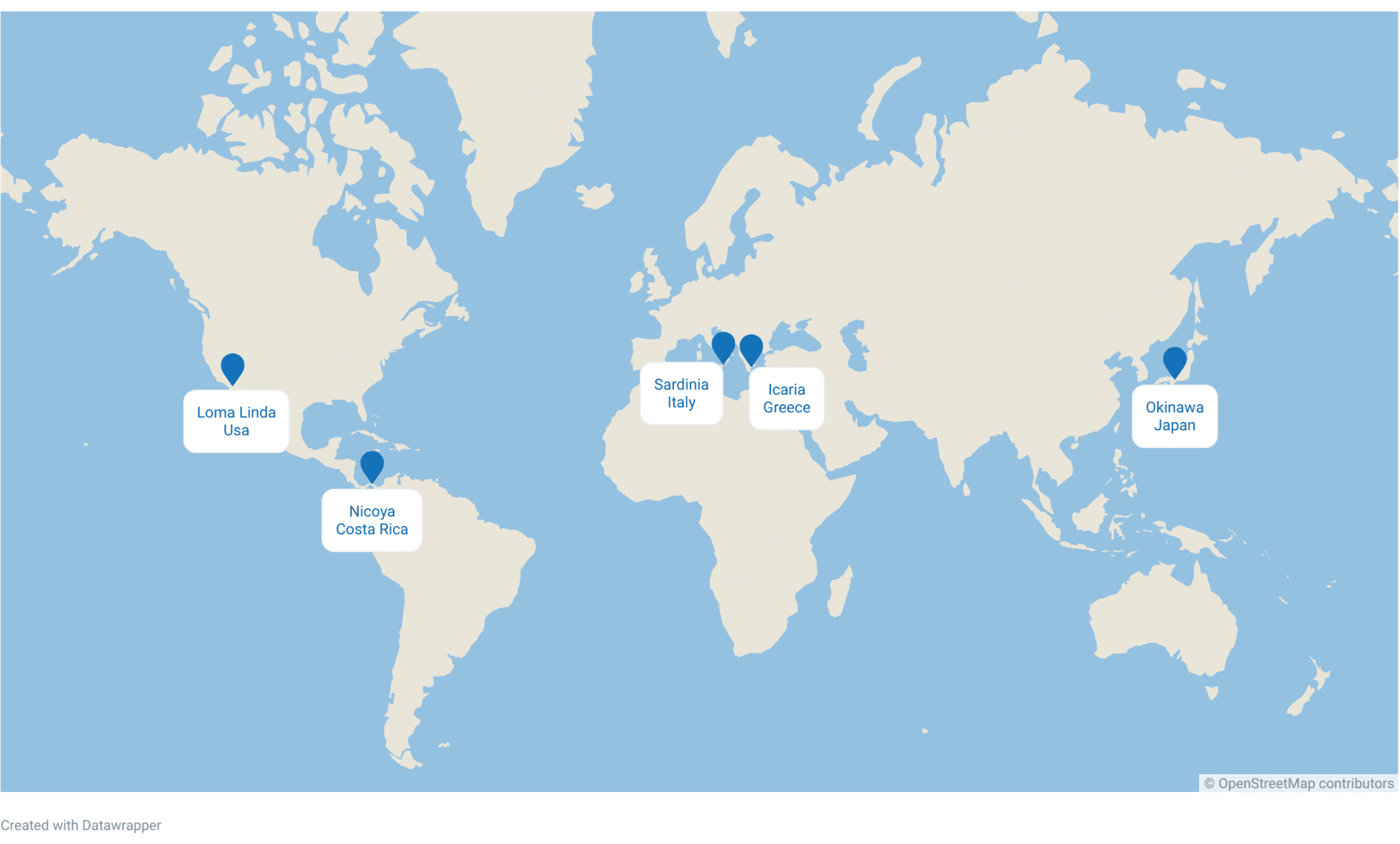Many intrepid explorers have searched for the mythical Fountain of Youth for centuries. The legendary spring is said to restore the youth of anyone who drinks or bathes in its waters. Tales of such a fountain have been told for generations, and some allegedly searched for it in Florida in the 16th century.
While the magical water source has yet to be found, there are other real-world locations that can boost one’s longevity. Intrigued by tales of exceptionally long-living residents, researcher and National Geographic explorer Dan Buettner traveled to Japan in 2000 to investigate such claims.
What he found was astonishing. Okinawa residents enjoyed remarkable longevity and health. Coupled with Asian traditions, beliefs, and a healthy plant-based diet, the average lifespan of a resident has historically been among the highest in the world.
Buettner discovered four more such locations, and in this article, we’ll explore where these Blue Zones are, what makes them unique and why they are excellent choices for retirement and real estate investments.
What are Blue Zones?
As identified by researcher Dan Buettner, Blue Zones are regions where people live significantly longer, healthier lives. From the start of his research in 2000, he found five places where a plant-based diet, regular physical activity, strong social ties, and low-stress levels contribute to residents living longer than anywhere else.
Blue Zones stand out significantly when compared to average life expectancies both globally and within their respective countries. Worldwide, the average life expectancy is around 72.6 years. However, residents of Blue Zones, such as Okinawa in Japan, often live well into their 80s and 90s, surpassing Japan’s national average of about 84 years.
Similarly, in Sardinia, Italy, many people live into their 90s, exceeding Italy’s national average of 83 years. In the Nicoya Peninsula of Costa Rica, longevity is remarkably high, with residents frequently living past 90, compared to Costa Rica’s average of 80 years.
The common thread among these regions includes a combination of healthy diets, regular physical activity, strong social ties, and a sense of purpose.
Reasons for Longevity in Blue Zones
Monaco has the highest average lifespan in the world, with residents living an average of 87.14 years. Unsurprisingly, their longevity is attributed to high disposable income in addition to excellent state-funded healthcare and a healthy Mediterranean diet.
But that isn’t always (or rarely is) the case for the locations found by Buettner. While disposable income can enhance your golden years, residents in Blue Zones all share distinct characteristics.
- Plant-Based Diet
The diets in these areas are predominantly plant-based, rich in vegetables, fruits, whole grains, and legumes, with limited consumption of meat and processed foods and moderate alcohol consumption (particularly wine). According to studies, this kind of diet provides essential nutrients and antioxidants, promoting overall health and reducing the risk of chronic diseases.
- Physical activity
Coupled with healthy eating habits, regular physical activity is a natural part of daily life in Blue Zones. Rather than engaging in intense exercise routines, residents incorporate movement into their routines through activities like gardening, walking, and manual tasks, which help maintain fitness and mobility.
- Strong Social Connections
Since humans are incredibly social, a sense of community also plays a crucial role in these areas. Buettner noted that residents have strong family ties, frequent social interactions, and supportive relationships that contribute to emotional well-being.
- Moderate Alcohol Consumption
Except for Loma Linda, where the Adventist community often abstains from alcohol, moderate consumption of alcohol, particularly wine, is common in other Blue Zones. It is usually consumed in social settings and with meals.
- Stress Reduction Practices
Each Blue Zone community engages in practices that help manage and reduce stress, such as daily naps, meditation, and communal activities. Another common aspect of these areas is regular engagement in spiritual or religious practices.
What are the 5 Blue Zones of the world?
Officially, Buettner has identified five Blue Zones worldwide. Each location is as unique as the country it’s in, but the residents of the towns in Japan and Costa Rica have a secret weapon that the others don’t: positivity.
In Okinawa, there is “ikigai,” and Nicoya has “plan de vida,” which is essentially a sense of purpose that provides motivation and a positive outlook on life, which can enhance mental health and resilience.
Sardinia, Italy
Sardinia is recognized as a Blue Zone due to the exceptional longevity of its residents, particularly in the mountainous Nuoro province, where a significant number of men live to over 100.
The traditional Mediterranean diet is rich in vegetables, fruits, whole grains, and healthy fats from olive oil, all of which play a significant role in the health of Sardinians. They also consume moderate amounts of wine, which is high in antioxidants.
Physical activity is naturally integrated into daily life through farming, shepherding, and walking on hilly terrain. Strong family ties and social connections provide emotional support and reduce stress.
Additionally, Sardinians maintain a low-stress lifestyle, enjoying a relaxed pace of life that contributes to overall well-being. Due to Sardinia’s geographical separation from mainland Italy, the residents carry the M26 genetic marker, which is exceedingly rare outside the island. This genetic anomaly is clinically linked to an extended life expectancy.
Ikaria, Greece
Ikaria, an island in the Aegean Sea, is renowned as a Blue Zone because a significant percentage of its population lives well into their 90s and beyond. The Ikarian diet is a cornerstone of their health. It is predominantly plant-based, rich in vegetables, legumes, fruits, and whole grains, and incorporates healthy fats from olive oil.
The diet is also low in processed foods and meat, which helps reduce the risk of chronic diseases like heart disease and cancer. Herbal teas made from wild plants, such as sage and dandelion, are commonly consumed and are believed to have anti-inflammatory and antioxidant properties.
A common trait among Blue Zones, physical activity is a natural part of daily life in Ikaria. The island’s rugged terrain means that walking and physical labor are part of everyday routines, contributing to cardiovascular health and overall fitness. Gardening, farming, and tending to livestock are common activities that keep the elderly population active.
Additionally, Ikarians live a low-stress lifestyle. The island’s slow pace allows for ample time to rest and socialize. Afternoon naps, known as “siestas,” are common and contribute to reduced stress levels and better heart health. Regular, moderate consumption of locally produced wine, often enjoyed during social gatherings, also contributes to cardiovascular benefits.
Okinawa, Japan
Okinawa residents enjoy remarkable longevity and health, tapping into several Asian traditions and beliefs. The only Blue Zone in the region, it has an average life expectancy of 84 years and the highest proportion of centenarians, with nearly 10% of the population aged 100 or more.
A fundamental part of everyday life is the concept of “Ikigai,” meaning “a reason to live.” This philosophy provides direction, motivation, and a sense of purpose to both young and old, whether through work, family, community service, or hobbies. Social connections, or “Moai,” are another key element. These lifelong social groups offer support, companionship, and laughter, fostering emotional well-being and reducing stress
But it’s not just a sense of community that keeps them going. The Okinawan diet, predominantly plant-based, is rich in nutrients and antioxidants and low in fat. Meals commonly include vegetables, tofu, sweet potatoes, seaweed, and seafood, which support heart health and overall well-being.
And as with all Blue Zones, the final key to a long life is physical activity. Daily walking and group exercises like “Radio Taiso” are common, providing low-impact, short-duration workouts that keep residents active and fit.
Nicoya Peninsula, Costa Rica
Like the residents of Okinawa, those living in the Nicoya Peninsula live by the “plan de vida” mantra, or “reason to live.” However, that’s not the only fascinating aspect of the only Blue Zone in Latin America.
We all know that regularly drinking water is good for your health, but the Nicoya Peninsula is as close to the Fountain of Youth as you’ll ever get. Nicoyans consume water naturally high in calcium and magnesium, supporting bone health and overall bodily functions. This high-quality water contributes significantly to their health and longevity.
Also, the Nicoyan diet is primarily plant-based and includes staples such as beans, corn, rice, and a variety of fresh fruits and vegetables.
These foods are rich in essential nutrients, antioxidants, and fiber, contributing to overall health and reducing the risk of chronic diseases. Many residents also engage in farming, gardening, and other manual labor, which keep them physically active and fit well into old age.
Loma Linda, California, USA
The lifestyle and community practices in Loma Linda are deeply influenced by the principles of the Seventh-day Adventist Church, which emphasizes holistic health and well-being. The Adventist health message advocates for a plant-based diet rich in fruits, vegetables, nuts, seeds, and whole grains.
Many residents avoid meat and consume minimal amounts of processed foods and sugars. The emphasis on plant-based nutrition is linked to lower risks of chronic diseases such as heart disease, diabetes, and cancer.
Strong social connections and a supportive community also play a crucial role in the health and longevity of Loma Linda residents. The Adventist Church fosters a tight-knit community where members support each other through regular social gatherings, church activities, and communal worship. This sense of belonging and mutual support reduces stress and promotes mental well-being.
Finally, spirituality and faith are integral to the lifestyle of residents. The Adventist belief system includes regular observance of the Sabbath, which provides a weekly day of rest and spiritual rejuvenation.
Consider a Blue Zone for Retirement
European Blue Zones, such as Sardinia in Italy and Ikaria in Greece, are ideal for expat retirees seeking a healthy and fulfilling retirement. These regions offer several advantages that enhance the quality of life for retirees.
Known for their strong social connections, close-knit communities, and meaningful interactions, these regions can reduce stress, improve mental health, and foster a sense of belonging. The relaxed pace of life in these regions allows retirees to enjoy a low-stress lifestyle, with an emphasis on work-life balance, leisure, and family time contributing to lower stress levels and improved mental health.
The Mediterranean diet, common in these areas, is rich in fresh fruits, vegetables, whole grains, and healthy fats from olive oil, which promotes heart health and longevity. Retirees can enjoy delicious, nutritious food that supports overall well-being and reduces the risk of chronic diseases.
Additionally, the natural beauty and pleasant climate of these areas make them attractive destinations for retirement, offering stunning landscapes, mild weather, and a slower pace of life, creating an ideal environment for a peaceful and enjoyable retirement.



